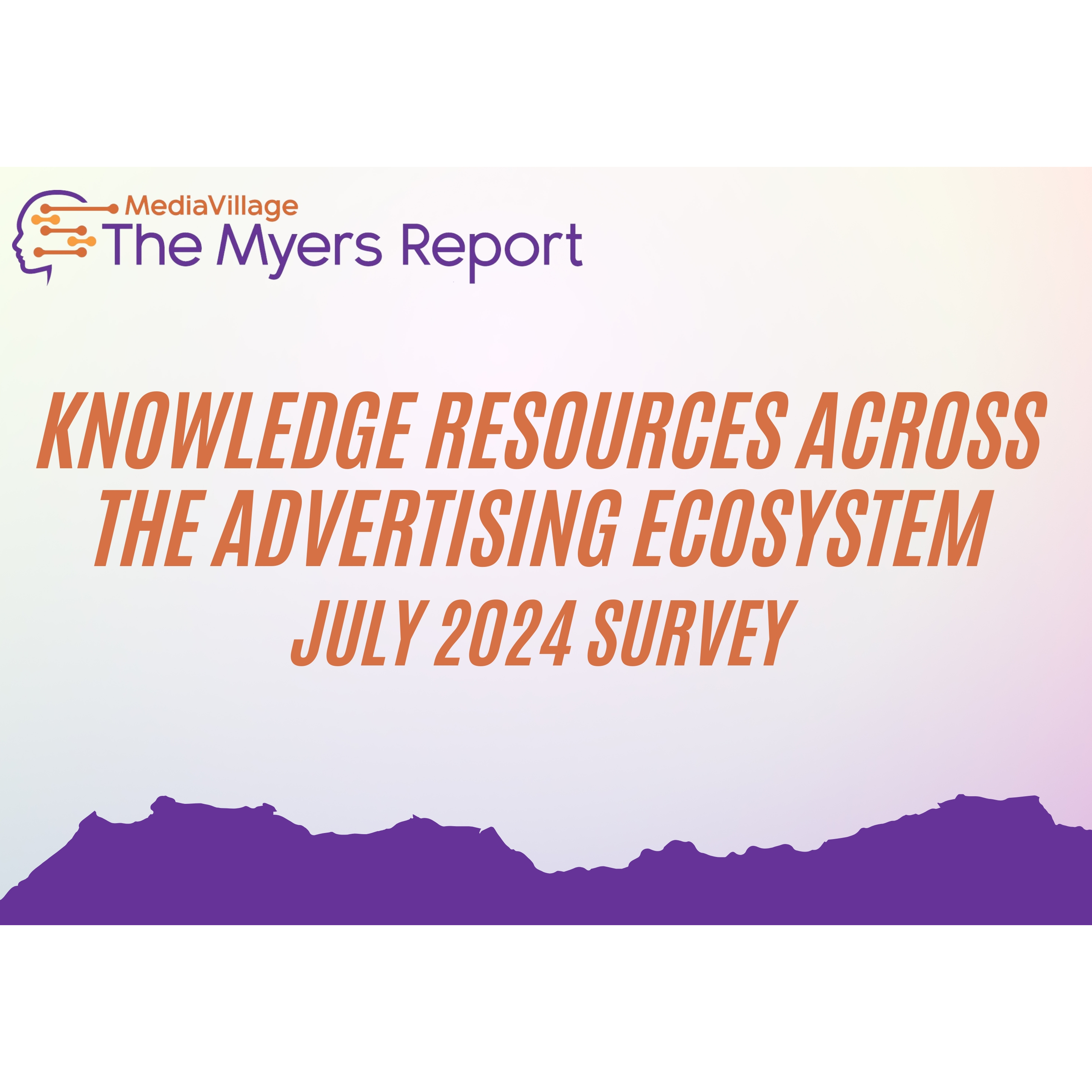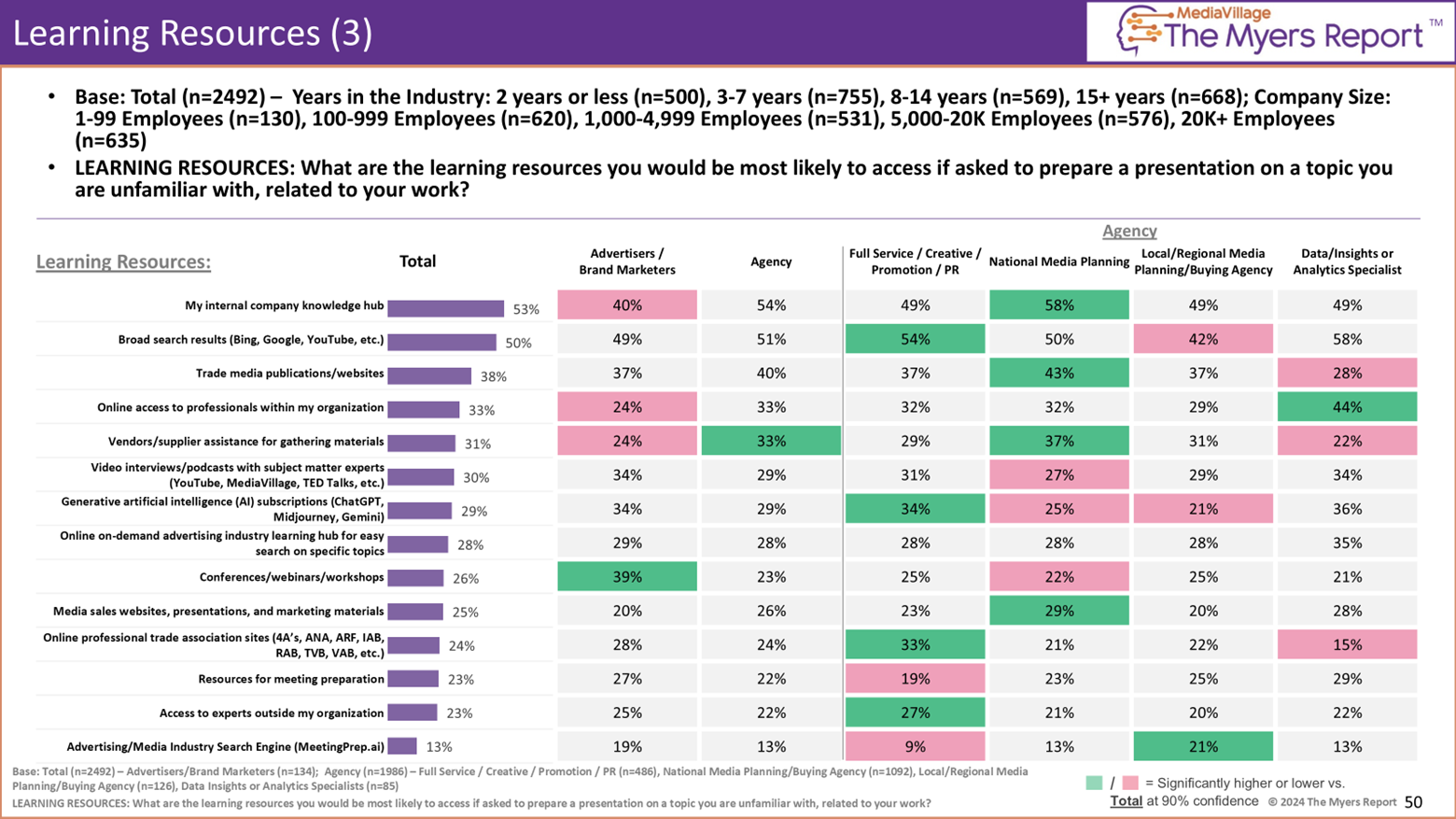Knowledge Resources Across the Advertising Ecosystem -- The Myers Report (July 2024 Survey)

The Myers Report, in collaboration with the Association of National Advertisers (ANA), the American Association of Advertising Agencies (4A’s), MediaVillage Education Foundation, and leading media agencies, conducted a survey in July 2024 among U.S.-based advertising professionals. With a total of 2,492 respondents, the survey explored the learning resources professionals turn to when asked to prepare presentations on unfamiliar topics related to their work. The survey captures key insights segmented by years of experience and company size, revealing critical trends and gaps in access to industry knowledge resources. The findings underscore opportunities for the advertising ecosystem to invest in resources and infrastructure that better serve employees at all levels.
Key Findings: Learning Resources Utilized by Advertising Professionals
- Top Learning Resources Accessed by Respondents:
- Internal Company Knowledge Hub (53%): The most frequently accessed resource, highlighting the reliance on internal networks and materials.
- Broad Search Engines (50%): Platforms like Google, Bing, and YouTube are heavily utilized for general research.
- Trade Media Publications/Websites (38%): Industry-specific media remains an essential tool, though access to these resources is uneven across different groups.
- Online Professional Networks within Organizations (33%): Reflects the value placed on networking with internal colleagues.
- Emerging Learning Tools:
- Video Interviews/Podcasts (30%): Platforms like YouTube, MediaVillage, and TED Talks offer professionals multimedia learning experiences.
- AI Tools (29%): Subscriptions to tools like ChatGPT, Midjourney, and Gemini are gaining traction, signaling a shift toward leveraging generative AI for professional development.
- On-Demand Industry Learning Hubs (28%): These resources facilitate easy access to industry-specific topics and training.
- Underutilized Learning Resources:
- Advertising/Media Industry Search Engines (13%): Resources such as MeetingPrep.ai are underused, suggesting a need to improve their visibility or perceived value.
- Access to Experts Outside the Organization (23%): Limited reliance on external expertise reflects potential barriers, such as budget constraints or time limitations.
Differences Across Cohorts
Experience Levels
- Professionals with 15+ years of experience are more inclined to use internal resources (54%) and trade publications (44%), demonstrating reliance on specialized knowledge and established internal processes.
- Early-career professionals (2 years or less) show a higher reliance on AI tools (32%) and external assistance (24%), indicating their openness to new technologies and external collaboration.
Company Size
- Smaller organizations (1-99 employees) have the lowest usage of internal knowledge hubs (38%) but rely heavily on broad search engines (55%) and video resources (43%).
- Larger organizations (20K+ employees) excel in internal knowledge sharing (57%) and make greater use of professional trade associations (37%), showing a structured approach to internal learning and industry engagement.
- Mid-sized companies (100-999 employees) stand out for utilizing trade media (35%) and AI tools (31%), indicating adaptability and resourcefulness.
Analysis and Recommendations
The survey highlights a clear dependence on internal company resources and broad online search platforms as primary sources of learning. While these resources provide accessibility and convenience, low usage of trade publications and industry-specific platforms raises concerns about professionals’ access to up-to-date, high-quality industry insights.
Key Opportunities for Investment in Knowledge Resources:
- Expand Access to Trade Publications and Professional Associations:
- Trade publications (38%) are vital but underutilized, especially in smaller organizations and among junior professionals. Industry-wide investment in subscription access programs would democratize access to critical knowledge.
- Professional associations like the 4A’s and ANA must focus on increasing membership engagement by highlighting the value of their educational offerings, including curated webinars and training programs.
- Promote the Use of AI and Industry Learning Platforms:
- AI tools (29%) are increasingly popular among younger professionals, signaling a shift toward automated learning solutions. Employers should invest in enterprise-level AI subscriptions and foster training programs to increase proficiency across teams.
- Awareness campaigns for underutilized industry-specific search engines and on-demand learning hubs can drive adoption and better equip employees for future challenges.
- Enhance Access to External Experts and Vendor Support:
- Engagement with external experts and vendor-supported resources remains low (23% and 31%, respectively). Companies should formalize mentorship programs with external partners and offer financial support for employees seeking external expertise for projects and presentations.
- Prioritize Knowledge Sharing within Organizations:
- Larger companies excel at internal knowledge sharing, but smaller firms struggle to maintain the same level of resources. Creating inter-organizational networks or knowledge-sharing alliances can allow smaller firms to benefit from the expertise available in larger organizations.
The Myers Report survey reveals both strengths and gaps in how advertising professionals access learning resources. While reliance on internal hubs and general search engines is strong, the industry must address uneven access to trade publications, expert networks, and external learning resources. Targeted investments in AI tools, professional associations, and trade subscriptions will help democratize learning across organizations of all sizes, ensuring that advertising professionals at every stage of their career have the resources they need to thrive.
By addressing the current dissatisfaction with access to trade publications and enhancing investments in knowledge infrastructure, the advertising industry can empower its workforce and foster innovation, adaptability, and continuous learning across the ecosystem.


